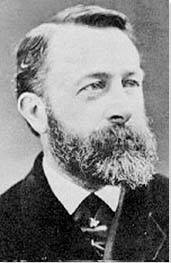Summary of Albert Bierstadt
Although taken to task by critics in his later years for being excessive and unrefined, Bierstadt is today widely considered one of America's greatest landscape artists; a man whose paintings offer a unique picture of American natural history during the second half of the nineteenth century. Produced from photographs and sketches, he made epic panoramas of the untamed American West that proved immensely popular with the American public. Vast in scale, and overwhelming in their emotional impact, he applied color for romantic rather than naturalistic effect. Strongly influenced by his tours of Europe, his paintings promoted the idea of conservation, culminating in the establishment of new National Parks, while at the same time highlighting the plight of Native Americans and the threat of extinction to the buffalo.
Accomplishments
- Bierstadt is linked to the second-generation of Hudson River School painters. Like his contemporaries Frederic Church and Thomas Moran, Bierstadt gained renown for his willingness to trek vast distances, often over dangerous rugged terrain, in search of the most spectacular scenery. Taking his stylistic lead from the Düsseldorf School of landscapists, and inspired thematically by his own tour of Alpine regions of Switzerland and Italy, he produced a romanticized and finely detailed version of the American West which he composed from a choice of his own sketches and photographs.
- Although it is associated chiefly with paintings on a somewhat less grandiose scale, Bierstadt was nevertheless seen as a pioneer of the style that would become known as Luminism. It was a term used to describe landscapes with lustrous lighting effects that promoted a sense of contemplation and tranquility in the viewer. Indeed, Luminism was seen as a transcendental experience that could only be achieved by immersing oneself in the wonders of nature.
- Arguably Bierstadt's most famous painting, Domes of Yosemite (1867), helped promote what was to become perhaps America's most cherished natural wonder: the mountain peaks of the Yosemite Valley. The Art Institute of Chicago described how Bierstadt had "enhanced the natural scene by narrowing the valley and dramatically accentuating the heights of the mountains" in a way that invoked the "gothic architecture and the soaring heights of a medieval cathedral's central nave". Such was the success of this painting that in 1882 a viewing platform was installed at the same vantage point from where Bierstadt initially composed his scene.
- Towards the end of his career, Bierstadt complemented his American and European works, with a series of "tropical" landscapes which he composed while staying in the Bahamas. Moving away from his Luminist technique, his Bahamian works showed the artist in a more expressive state of mind. These land and seascapes used bolder, more brilliant, colors and were concerned, not so much with the sublime presence of nature, but rather the lives and daily activities of local inhabitants.
The Life of Albert Bierstadt
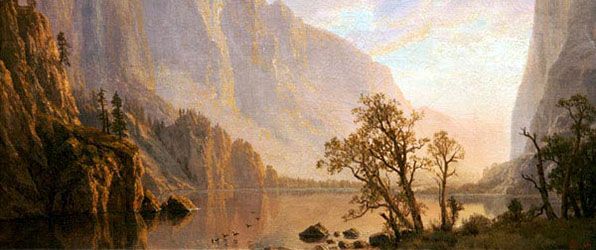
Bierstadt belongs to that group of artists for whom nature was to be treated as a sublime force, "The magnificent beauty of the natural world is a manifestation of the mysterious natural laws", he said, and predicted that despite the very best efforts of artists, the natural world would "be forever obscured from us".
Important Art by Albert Bierstadt
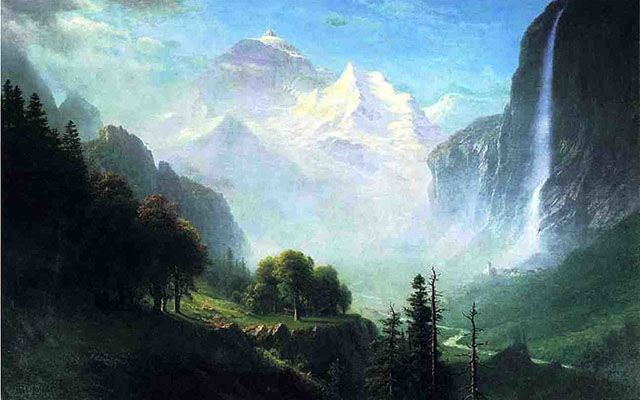
Staubbach Falls, Near Lauterbrunnen, Switzerland
This early work by Bierstadt was produced during the final year of his four-year tour of Europe, where he learned to paint en plain air under the mentorship of German-American history painter Emanuel Leutze and American landscape painter Worthington Whittredge. When he created this work, which presents a forested valley with cascading waterfalls to the right, and imposing, snow-covered mountains in the background, he was traveling with Whittredge through the Swiss Alps. There is little doubt that Whittredge (who himself spent the first sixteen years of his life in the fields and forests of rural Ohio) instilled in Bierstadt a sincere and profound admiration and affection for the divine beauty and power of nature.
This work underlines the way in which Bierstadt was influenced by Whittredge and, albeit indirectly, by other members of the Düsseldorf School of Painting. These artists focused on presenting romanticized, dramatic, detailed landscapes using subdued and well-balanced color palettes. Indeed, Bierstadt was instrumental in introducing the Düsseldorf School approach to the Hudson River School of artists when he returned to the United States. As arts writers Martha N. Hagood and Jefferson C. Harrison note, Bierstadt also took from the Düsseldorf painters the "idea that landscapes were to be seen as multiple views and examined in great detail".
Evidently, Bierstadt continued to use his experiences in Europe as a reference point even after his return to the United States. In an 1859 letter to the nineteenth-century journal The Crayon, he wrote "If you can form any idea of the scenery of the Rocky Mountain and of our life in this region [...] I shall be very glad [...] The mountains are very fine; as seen from the plains, they resemble very much the Bernese Alps, one of the finest ranges of mountains in Europe, if not the world. They are of granite formation, the same as the Swiss mountains and their jagged summits, covered with snow and mingling with the clouds, present a scene which every lover of landscape would gaze upon with unqualified delight".
Oil on canvas - Private Collection
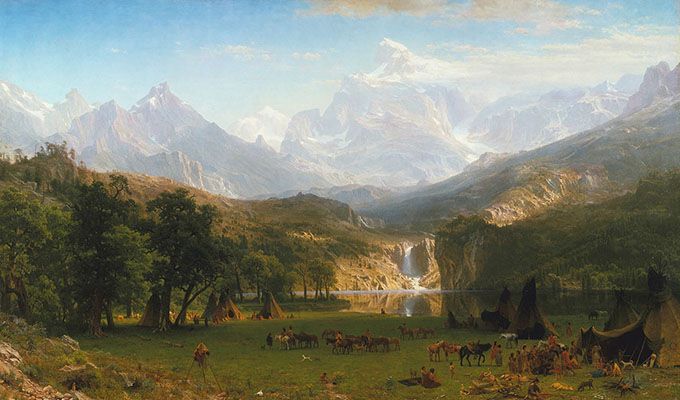
The Rocky Mountains, Lander's Peak
This painting secured Bierstadt's position as the foremost American landscape painter of his day. It was produced in his New York studio based on sketches and photographs he produced during the 1859 survey expedition to the Rocky Mountains. He presents a verdant, untamed landscape with an encampment of Native Americans in the foreground, and the majestic soaring mountains in the background. Indeed, what set Bierstadt apart from other members of the Hudson River School was his focus on the Western regions of the country, and his expeditions there.
Like so many of his works from this period, the painting served as a sort of advertisement for an untamed "promised land" to be conquered by White settlers. Bierstadt did not, however, present the landscape as it appeared, but rather altered aspects of it to amplify its effect on the viewer. For instance, he illuminated the waterfall in the mid-ground with an almost divine light, emphasizing the beauty of the scenery. Indeed, the term "luminism" has been applied to this type of hazy lighting effect, popular with American landscape painters of the mid-nineteenth century (particularly those of the Hudson River School), which conveys a sense of tranquility, and enhances the sense of the sublime; that being the evocation, through art, the feeling of being humbled by the power and majesty of nature. The Luminist style also required that the artists' brushwork remained transparent as to avoid any potential distraction from the sheer majesty of the view.
The inclusion of the Native American settlement (a motif that Bierstadt repeated in other works, such as Merced River, Yosemite Valley (1866)) adds to the sense of exoticism of the landscape. However, it seems that Bierstadt also intended for the Native Americans in his paintings to serve as a visual record of their existence. In a letter to the journal, The Crayon (dated 1859) he wrote: "We often meet Indians, and they have always been kindly disposed to us and we to them; but it is a little risky, because being very superstitious and naturally distrustful, their friendship may turn to hate at any moment [...] The manners and customs of the Indians are still as they were hundreds of years ago, and now is the time to paint them, for they are rapidly passing away; and soon will be known only in history".
Oil on canvas - The Met Museum, New York, New York
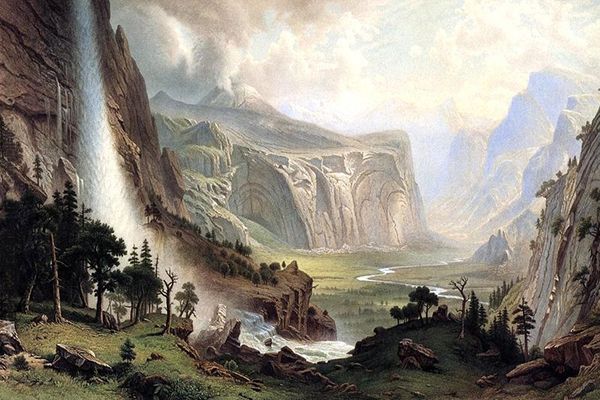
The Domes of the Yosemite
The New York banker and financier, Legrand Lockwood, commissioned Bierstadt to create this work for what was then the astronomical fee of $25,000. The painting, which was to take pride of place at Legrand's newly built home in Connecticut, reveals the famous Yosemite Valley; its peaks and sheer cliffs, soaring waterfalls, grassy plains, and winding river, in all its natural glory. The painting exemplifies Bierstadt's use of glowing and diffuse lighting effects to heighten the sublime sensibility of his scene. It also reveals the influence of the Düsseldorf School on his work; notably through its high degree of linearism - the focus on structural, architectural-like, representation of surfaces - as clearly evidenced here in the modeled rock faces.
Bierstadt based this, his largest-ever painting, on sketches and photographs he took while on his second expedition West. He was joined by the author Fitz Hugh Ludlow who wrote of his first glimpse of the valley: "We did not so much seem to be seeing from that crag of vision a new scene on the old familiar globe as a new heaven and a new earth into which the creative spirit had just been breathed. I hesitate now, as I did then, at the attempt to give my vision utterance. Never were words so beggared for an abridged translation of any Scripture of Nature".
In the foreground, the shadows cast over the trees, grass, and rocky outcroppings serve an almost metaphorical purpose, alluding to the popular belief that this region of the country was a hidden paradise that, for the few who managed to access it, presented sublime views of the nation's untapped natural resources. Works such as these not only inspired a generation of explorers to venture westward, but also helped to motivate the government to protect the region from exploitation, culminating in President Abraham Lincoln including the region in the United States' first public land trust in 1864. In 1882, a viewing platform was installed at the same vantage point from which Bierstadt and Ludlow viewed this scene.
Oil on canvas - St. Johnsbury Athenaeum, St Johnsbury, Vermont
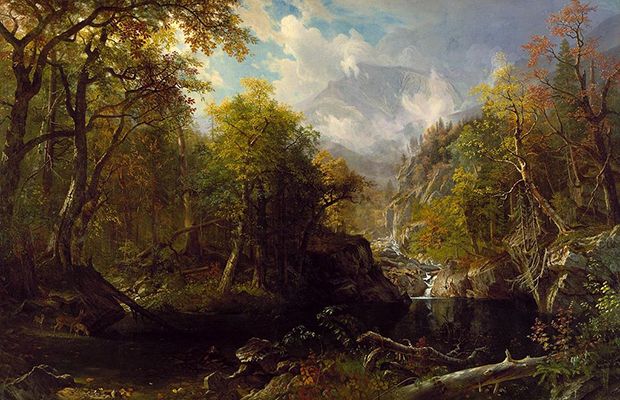
The Emerald Pool
Bierstadt said of The Emerald Pool, "I never had so difficult a picture to paint, [but] my artist friends think it is my best picture and so do I". The painting, based on some 200 sketches and three painted studies that he produced between 1852 and 1869, presents a scene at the Peabody River at the White Mountains in New Hampshire, which he often visited with his brother Edward (staying at the nearby Glen House tourist accommodation). The image shows a forest in late summer (with only some of the trees' green leaves beginning to turn yellow and orange) surrounding a lake, behind which a waterfall trails down a gentle slope from the mountain in the background, partially obscured by fluffy clouds.
In 1871, a critic for the San Francisco Bulletin wrote of The Emerald Pool: "We have seen no painting that came nearer our ideal of the best landscape art, combining perfect truth with freedom, largeness and sentiment". Similarly, arts writers Martha N. Hagood and Jefferson C. Harrison asserted that Bierstadt "depicts the wilds of New Hampshire as a new Eden, an unspoiled paradise of fierce beauty and absolute tranquility", adding that "Bierstadt's presence at the Glen House did not go unnoticed and his painting of The Emerald Pool actually increased tourism in the area". Indeed, numerous stereographic photographs produced by Bierstadt's brothers Edward and Charles of the site helped further promote tourism to the area.
This painting also exemplifies Bierstadt' association with the Hudson River School of artists, who, at a time when urban industrialization was on the march, sought to showcase the richness of the untamed American wilderness. To this end, Hagood and Harrison note that Bierstadt "depicts the cyclical aspects of nature through foliage in various stages of growth, death, decay, and rebirth as well as through the change of season from late summer to early autumn as demonstrated by the tonal variation in the foliage. Trees have fallen of their own accord, not felled by the clean edge of man's axe; no suggestion of the machine is seen in this garden [...] The viewer sees no hint of the rail system, luxury-enabling hotels, or the very commercial tourist industry just minutes from this scene of natural splendor".
Oil on canvas - The Chrysler Museum of Art, Norfolk, Virginia
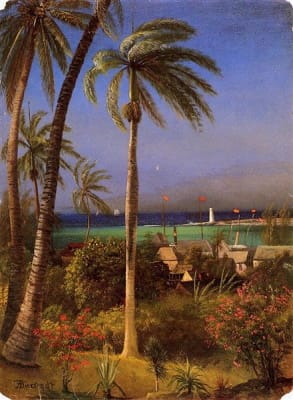
Bahamian View
Art historian William H. Gerdts argues that while Bierstadt is "justly regarded as one of the greatest of the landscape painters of the American West", he has received rather less attention for the "superb artistry [he brought] to his scenic depictions of other regions, [including his] small but compelling body of work in the Bahamas". When Bierstadt's wife Rosalie was diagnosed with Tuberculosis in 1876, she was advised by doctors to spend the colder months in a warmer climate and so the couple spent the winter months in Nassau where Bierstadt discovered a new sort of landscape to inspire him. In this work, for instance, we look past a grove of palm trees, blowing in the gentle tropical breeze, and other tropical shrubs and flowering bushes towards a small group of buildings with thatched rooves. Beyond that, we can view an emerald green bay, bordered in the distance by a rocky outcropping with a small white lighthouse and, in the far background, a deep blue sea dotted with white sailboats.
Bierstadt produced numerous other tropical landscape - such as Nassau Harbor (1877), Street in Nassau (1878), The Shore of the Turquoise Sea (1878), and A View of the Bahamas (1879) - that point to some stylistic cross-over with fellow American landscape painter Winslow Homer, who was also painting in the Bahamas around this time. In a departure from Homer, and indeed from his earlier American and European landscapes, Bierstadt's tropical land and seascapes used bolder, more brilliant, colors. As Gerdts concludes, "Though somewhat reminiscent of Bierstadt's oil sketches of Southern Italy and the beach at Capri painted in the late 1850s, [his Bahamian] pictures otherwise differ substantially from most of the rest of [his] works. In place of a concern with the natural sublime, Bierstadt investigated and captured the appearance of the town and landscape of Nassau and the lively activities of the local inhabitants, recorded in brilliant colours and suffused in warm sunlight".
Oil on canvas - Private Collection
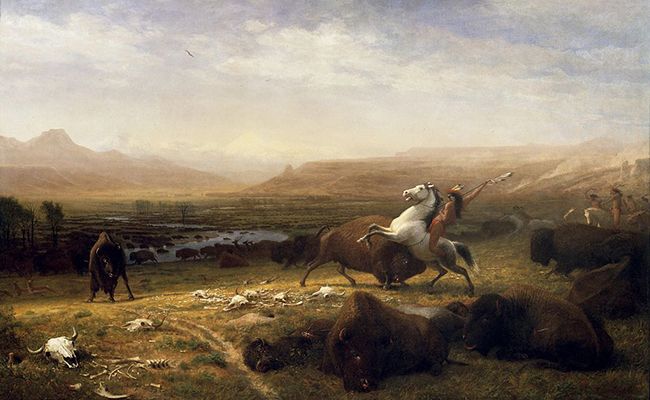
The Last of the Buffalo
The Last of the Buffalo marked a pivotal moment in Bierstadt's career. It was painted when the monumental romanticized landscapes to which his name was inextricably linked were being written off as excessive and old-fashioned. Undeterred, Bierstadt presented this composite Western landscape, most strongly informed by the Great Plains of the flatlands of North America. In the foreground, a group of Native Americans, wearing loincloths and feathered headdresses, and mounted on horses, battle a herd of buffalo, most of whom already lay slain at the bottom-right portion of the image. It was a controversial topic because at the time that the work was produced buffalo were thought to be facing extinction. As arts scholars Helena Wright, Linda Ferber, and Nancy K. Anderson note, this painting was "a masterfully conceived fiction that addressed contemporary issues" linking the diminishing number of buffalo to the circumstances of the Native American peoples, who were being relocated from their homes to reservations (following the "Indian Removal Act" of 1830).
When Bierstadt submitted the painting for the Paris Exposition Universelle of 1889, it was rejected. As arts writer Charles McQuillen notes, Bierstadt's "popularity had significantly declined and critics had become more vocal. His oversized canvasses were condemned as self-indulgent, his effects as excessive, and his compositions formulaic. Bierstadt's academic style was seen as old fashioned as Impressionism rose to prominence in the art world". Bierstadt was baffled and perturbed by the rejection, writing: "It is a matter of indifference to me but I cannot understand why you refuse my picture [The Last of the Buffalo] was one of my latest and was considered by my friends and competent critics as among my best efforts [...] I have endeavored to show the buffalo in all his aspects and depict the cruel slaughter of a noble animal now almost extinct. The buffalo is an ugly brute to paint, but I consider my picture one of my very best".
Oil on canvas - The National Gallery of Art, Washington DC
Biography of Albert Bierstadt
Childhood
Albert Bierstadt was the youngest of six children, and the middle of three brothers, born to Henry Bierstadt, a Cooper, and Christina M. Tillmans. Before Albert was two years old, the family emigrated to New Bedford, Massachusetts, where the whaling industry, and its high demand for barrels, provided Henry and his family with a comfortable standard of living. Bierstadt developed an early passion for art and, though paints proved hard to come by, he enjoyed sketching and drawing with crayons. It was, as Albert later recalled, a happy childhood, but little else is known about his early years. It is recorded, however, that while still a teenager he assisted English-born landscape painter George Harvey on a traveling show in which the artist projected images of his paintings onto a small theater screen (for an entrance charge of 25-cents).
Education and Early Training
Bierstadt was mainly self-taught and, at the age of twenty, started offering his services as a drawing teacher in New Bedford. One year later, he began to experiment with oil paints. He also exhibited thirteen of his works for the first time with the New England Art Union in Boston. Then, in 1853, after exhibiting at the Massachusetts Academy of Fine Arts, and after making a trip to New Hampshire's White Mountains range, he travelled to northern Europe where he hoped to study at the Düsseldorf School.
The Düsseldorf School was a run by a group of painters, including Andreas Achenbach, Karl Friedrich Lessing, Johann Wilhelm Schirmer, and Hans Fredrik Gude, who were part of the German Romanticism movement. These artists were advocates of the en plein air (in the open air) painting technique and their works often carried religious overtures. (Bierstadt had hoped to connect with his distant relative, and prominent member of the Düsseldorf school, Johann Peter Hasenclever, but Hasenclever had sadly passed away shortly before Bierstadt arrived.)
While in Düsseldorf, Bierstadt sought out the German-American history painter Emanuel Gottlieb Leutze and the American landscape painter Worthington Whittredge who he hoped would be able to convince Achenbach to take him on as his student. However, they judged Bierstadt's work to be overtly decorative and convinced him of the lie that Achenbach did not take on new students. The arts writer Charles McQuillen notes that Leutze and Whittredge did, however, encourage him to persevere with his own style which would ultimately give rise to "theatrical compositions, hard-edged Neoclassical drawing techniques, careful attention to detail, and romanticized landscapes [which were] sentimental, fanciful, and allegorical in content [and] painstakingly executed in a highly finished style".
Bierstadt remained in Europe for four years, where he devoted himself to his art. During his last year in Europe, he travelled with Whittredge through Germany, Switzerland, and Italy (where he spent the winter months visiting Rome, Naples, and Capri). He returning to New Bedford in 1857 as a matured artist. He taught drawing and painting for a brief period, before devoting his time fully to his own work.
Initially Bierstadt produced works based on fictional European scenes. Then, in late 1857, he joined Frederick W. Lander's overland survey, traveling to the western part of the United States and the Rocky Mountains. Lander had been contracted by the government to survey, engineer, and later build, what would become known as the "Lander Trail" across Wyoming and Idaho. Bierstadt made countless sketches along the way and also started to dabble in the new medium of photography. His sketches and photographs formed the basis for the vast vistas he would execute later in his studio. In 1859, Bierstadt travelled this time to the Platte River and Wind River Mountains, taking in the breathtaking scenery and sketching scenes of life for native inhabitants. He proceeded to the Rockies, where the views sometimes bettered even those of the European Alps. Bierstadt was so enthused he declared "Our own country has the best material for the artist in the world". His first important painting from this period (now lost) was Base of the Rocky Mountains (c.1860).
Mature Period
In the spring of 1858, Bierstadt impressed critics in New York, with a large painting of Lake Lucerne in the Swiss Alps, when it was included in the annual exhibition at the National Academy of Design (NAD). He made such an impression that a few weeks later he was made an honorary member of the NAD. He moved to New York and set himself up in the Tenth Street Studio Building. Bierstadt soon developed a strong reputation for his paintings of the mountainous American West, including one of his most highly praised works, The Rocky Mountains, Lander's Peak (1863). Around this time, he also established a successful photography business in New York City with his brothers Charles and Edward (the business ran from 1860 to 1866).
In early 1863, Bierstadt headed westward once more, this time with author Fitz Hugh Ludlow (perhaps best known for his book The Hasheesh Eater, which detailed his experiences using drugs). The two men passed through Utah and San Francisco, spending seven weeks in the Yosemite Valley, before making their way back home via Oregon. Soon after, Ludlow and his wife, Rosalie, divorced leaving her free to court Bierstadt. Despite this, Ludlow and Bierstadt remained close friends with Ludlow emerging in fact as one of the artist's strongest champions. (He wrote about their expeditions in articles for The Atlantic Monthly, and later, in a book titled The Heart of the Continent (1870). Ludlow was also the art critic for The New York Evening Post for which he wrote laudatory reviews of Bierstadt's paintings.)
Later in 1863, Bierstadt was called up for military service but paid another man to serve in his place. The following year, his painting Rocky Mountains was exhibited at the New York Sanitary Fair next to the work of the highly respected landscapist, Frederic Edwin Church. It was praised by influential art critic James Jackson Jarves for displaying "an unsurpassed rendition of American light". In 1865, with his reputation now in the ascendency, Bierstadt built a home/studio, named "Malkasten", in Irvington, North of New York City, which overlooked the Hudson River. From here, Bierstadt ventured to New England and New Hampshire, often with his brother Edward (as a photographer). It was in New Hampshire in fact that he executed what is considered by many to be amongst his most accomplished works, Emerald Pool (1870).
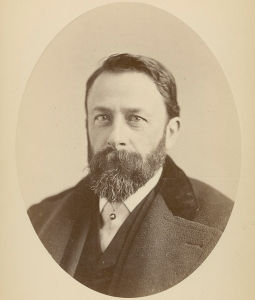
Bierstadt became associated with the so-called second-generation Hudson River School. The artists were considered "second" because they ventured beyond the immediate Hudson region to more far-flung domestic locations. Indeed, Bierstadt (along with Thomas Moran) shifted his focus geographically and presented the Western landscape as the epitome of the nation's untapped natural resource. Moreover, whereas the Hudson's group's founder, Thomas Cole, placed emphasis on creating sublime, allegorical images of nature, the second-generation artists shifted their approach, focusing more on careful observation of the landscape, and the production of paintings that prompted a sense of contemplative serenity in the viewer.
By helping raise the great American West to a level of national consciousness, Bierstadt became linked to the concept of Manifest Destiny. This was the belief, widely held in nineteenth century America, that the white settlers of the West had accepted a God-given mission to conquer their environment as a way of creating a new "heaven on earth" (namely America). As historian Anne F. Hyde puts it, "Bierstadt painted the West as Americans hoped it would be, which made his paintings vastly popular and reinforced the perception of the West as either Europe or sublime Eden".
Late Period
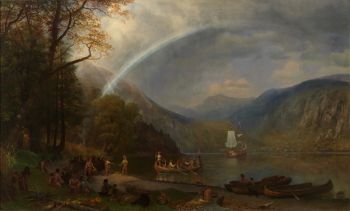
In 1866 Bierstadt and Rosalie were married and the newlyweds spent two years touring Europe. While in London they were granted an audience with Queen Victoria (a known admirer of his work); in Paris, Bierstadt received the prestigious Legion of Honour medal; and in Rome, the couple socialized with the renowned composer Franz Liszt. During these travels Bierstadt rented studios and continued to paint. Once Back in America, he headed West once more, this time to the Yosemite and Sierra Nevada region. Bierstadt stayed two years, sketching, and painting, and selling works to collectors in the local area.
In July 1871, the Bierstadt's travelled to San Francisco on the newly built transcontinental railroad. They remained in California until October 1873. In 1875, Bierstadt's painting The Discovery of the Hudson (1874) was installed in the United States Capitol Building, and the following year he was invited to visit the White House by President Rutherford B. Hayes. However, Bierstadt's work for the 1876 Philadelphia Centennial was not at all well received and signaled the beginnings of a downturn in his artistic fortunes.
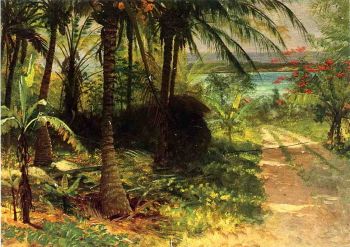
In autumn 1876, Rosalie was diagnosed with tuberculosis and advised by her doctor to recuperate in warmer climates. On her doctor's advice, the Bierstadt's retreated in the colder months to the Bahamas where Bierstadt sketched and painted the local tropical landscapes and seascapes with renewed vigor. Indeed, his painting, The Shore of the Turquoise Sea (1878), was perhaps his last critical success when it was exhibited at the National Academy of Design in 1880.
In 1882, Bierstadt's studio ("Malkasten") burned down, and he lost many works. This harsh setback coincided with a depressed art market. But the hardest blow to his morale came when his entry for the 1889 Exposition Universelle in Paris, The Last of the Buffalo (1888), was rejected by the American selection committee. That same year Bierstadt made his final journey West, and then all the way North to Alaska. Sadly, however, he was being overshadowed by the rise of North American landscapist George Inness, an artist strongly influenced by the French Barbizon School, who was exploring Tonalism (a more tempered style that favored a limited range of middle value colors) and whose style was winning over critics and fellow artists.
In 1893 Rosalie passed away. The following year he remarried to a wealthy widow, but, due to an extravagant lifestyle, he declared personal bankruptcy. He was forced to sell his entire property and assets, including 150 paintings, to satisfy his creditors. Bierstadt spent his final years more-or-less forgotten; his works dismissed as overblown and outdated. He passed away suddenly on February 18, 1902. Buried at the Rural Cemetery in New Bedford, Massachusetts, he was posthumously honored when Colorado's Mount Bierstadt was named in his honor.
The Legacy of Albert Bierstadt
With other second-generation members of the Hudson River school (including Asher B. Durand, John Frederick Kensett, Sanford Robinson Gifford, Thomas Moran, and Frederic Edwin Church), Bierstadt became famous in the nineteenth century for painting expansive vistas of the American landscape (not to mention landscapes of Europe, Canada, and the Bahamas). But what set Bierstadt (and Moran) apart from other Hudson School associates was his focus on the unexplored American West. In this respect he helped introduce the wider American public to its unclaimed frontiers and the untamed wilderness. Indeed, his scenes of an American "Promised Land" entered into the consciousness of the nation and inspired a generation of explorers and settlers to venture westward.
Although the style of Bierstadt and the Hudson River School artists fell out of favor at the end of the nineteenth century, artists of the American Regionalism movement of the 1930s (including Thomas Hart Benton, Grant Wood, and John Steuart Curry) showed their debt to the Hudson River School through a focus on detailed, realistic, and indeed often idealized, images of rural America at a time when much of the population had grown disillusioned with urban life and modern industry in the fallout from the Great Depression. Moreover, the approach of Bierstadt and other Hudson River School artists filtered down to twentieth century landscape photographers, such as Ansel Adams, whose breathtaking photographic vistas captured the majesty of the American landscape while at the same time supporting the causes of conservation through the establishment of National Parks.
Influences and Connections

- Emanuel Leutze
- Worthington Whittredge
- Richard Caton Woodville
- Eastman Johnson
- James McDougal Hart
-
![Frederic Edwin Church]() Frederic Edwin Church
Frederic Edwin Church -
![Thomas Moran]() Thomas Moran
Thomas Moran - Franz Liszt
- George Harvey
- William Stanley Haseltine
- William Bliss Baker
-
![Frederic Edwin Church]() Frederic Edwin Church
Frederic Edwin Church -
![Thomas Moran]() Thomas Moran
Thomas Moran - Franz Liszt
- George Harvey
- William Stanley Haseltine
-
![The Hudson River School]() The Hudson River School
The Hudson River School -
![Luminism]() Luminism
Luminism - The Rocky Mountain School
Useful Resources on Albert Bierstadt
- Albert Bierstadt: Painter of the American WestOur PickBy Gordon Hendricks
- Albert Bierstadt (American Art Series)By Tom Robotham
- The Heroic Journey of Albert Bierstadt: Artist-Priest of the WestOur PickBy David M. Delo
- Albert Bierstadt: Witness to a Changing WestOur PickBy Peter H. Hassrick
- Albert Bierstadt : Art and Enterprise Paperback - December 1, 1990By Nancy K. Anderson and Linda S. Ferber
- The Rockies and the Alps: Bierstadt, Calame and the Romance of the MountainsOur PickBy Katherine Manthorne and Tricia Laughlin Bloom
- Bierstadt's WestBy Gerald L. Carr
- Albert Bierstadt: Puget Sound on the Pacific CoastBy Patricia A. Junker
 Ask The Art Story AI
Ask The Art Story AI